From maintaining the grounds, to stringing rackets, to keeping the entertainment on schedule, many people will play key behind-the-scenes roles at this year’s event. Here are a few who will make their mark.
Michael Fiur
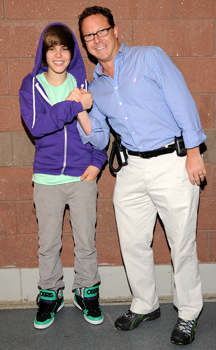 |
Fiur with Justin Bieber
Photo by: USTA |
If someone’s doing something on center court in Arthur Ashe Stadium other than playing tennis, Fiur likely isn’t far away. From selecting the music, to the videos on the big screen, he likely came up with that day’s rundown. As executive producer of entertainment, Fiur produced the opening of Arthur Ashe Stadium featuring Whitney Houston in 1997, and since then has produced dozens of ceremonies including the dedication of the Billie Jean King National Tennis Center and the 40th anniversary of the U.S. Open. Fiur produces live events and television specials, having founded his own company after 10 years at Radio City/MSG Entertainment. For the NFL, Fiur will produce the Super Bowl postgame ceremony in New Orleans in February, his 18th Super Bowl production in all.
Barbara Paddock
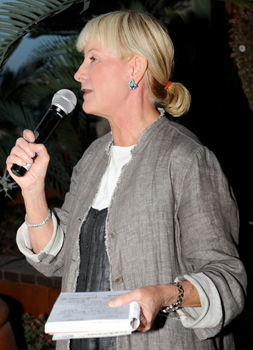 |
| Photo by: JPMorgan Chase |
In New York sports, there may be no greater hospitality tradition than JPMorgan Chase at the U.S. Open. At the center of it is Paddock, the bank’s point person with the tournament. She will spearhead the effort to shepherd thousands through the bank’s hospitality space, a key two weeks for the bank as it entertains some of its most important clients and executives. The bank will spend tens of millions of dollars on the Open’s sponsorship, and it is the hospitality far more than the branding that is key to the deal. Officially senior vice president of the bank for strategic philanthropic initiatives, Paddock has an unofficial role in tennis circles: the person to know for the best food and relaxation while at the Open.
Roman Prokes
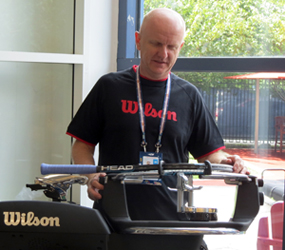 |
| Photo by: USTA |
Prokes arguably has the most important job this fortnight at the U.S. Open — racket stringer. Players often take six or seven rackets onto court, and the show can’t go on unless those rackets are strung to the preferred tensions. That job falls to Prokes, who is the official U.S. Open racket stringer and works on site during the event. During last year’s Open, Prokes strung 3,521 rackets. That’s enough racket string to lay the entire course of a marathon, and a bit more. During the rest of the year, Prokes can be found in one of his three metro New York stores. A Czech who fled communist oppression in 1981 for the United States, Prokes played, too, and is always in high demand by recreational players and pros alike. Especially over the next two weeks.
Danny Zausner
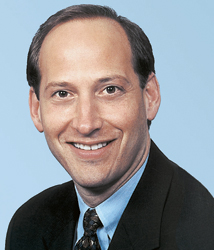 |
| Photo by: USTA |
If a flower is trampled on the grounds of the U.S. Open this week and not immediately replaced, chances are Zausner will not be happy. The head of facilities for the Billie Jean King National Tennis Center, Zausner is the point person for merchandise, food and beverage, coordinating with city authorities, and even the luxury suites. He oversaw the effort last year to essentially strap down the site the weekend before the tournament began when Hurricane Irene blew in, then got the facility ready to open as usual. And not a flower was out of place.
Roy Fugazy
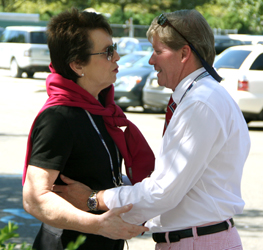 |
Fugazy greets Billie Jean King.
Photo by: Roy Fugazy |
Fugazy doesn’t work for the USTA, but one could argue there is no one more important to the U.S. Open running effectively. His Fugazy Sports & Entertainment operates 240 vehicles that will transport players, officials and VIPs from Manhattan to Queens and back. Unlike the other Slams where players usually stay near the venue, that is not the case with the year’s last Slam. Hotels are limited in Queens, and not up to the caliber many players demand. Each day Fugazy will transport about 7,000 passengers, including family members of players. Those vehicles will log 1.1 million miles this fortnight.
Jason Bernstein
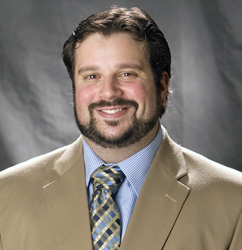 |
| Photo by: ESPN |
Bernstein has almost completed a Grand Slam of his own in the past year, securing extensions to the Australian and French Opens on top of bringing Wimbledon rights to ESPN. The executive has been with ESPN since 2002 and now is senior director of programming and acquisitions. He oversees all content acquisition and scheduling strategy for ESPN’s tennis business. He also handles contract discussions for competitive eating, watching the July 4 Nathan’s Famous hot dog eating contest every year from ESPN’s broadcast compound at Wimbledon.









